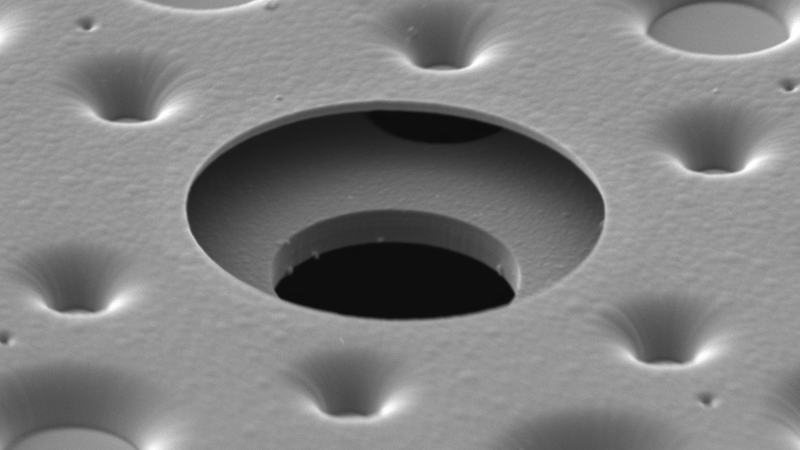If you’ve ever wondered what lies beneath the barely visible hole in the can of a MEMS microphone, you’re in luck, because [Zach Tong] has a $10 pair of earbuds to sacrifice for the cause and an electron microscope.
For the uninitiated, MEMS stands for microelectromechanical systems, the tiny silicon machines that power some of the more miraculous functions of smartphones and other modern electronics. The most familiar MEMS device might be the accelerometer that gives your phone a sense of where it is in space; [Zach] has a deep dive into MEMS accelerometers that we covered a while back.
MEMS microphones seem a little bit easier to understand mechanically, since all they have to do is change vibrations in air into an electrical signal. The microphone that [Zach] tore down for this video is ridiculously small; the SMD device is only about 3 mm long, with the MEMS chip under the can a fraction of a millimeter on a side. After some overall views with the optical microscope, [Zach] opened the can and put the guts under his scanning electron microscope. The SEM shots are pretty amazing, revealing a dimpled silicon diaphragm over a second layer with holes etched right through it. The dimples on the diaphragm nest into the holes, forming an air-dielectric capacitor whose capacitance varies as sound waves vibrate the diaphragm.
The most visually interesting feature, though, might be the deep cavity lying behind the two upper surfaces. The cavity, which [Zach] says bears evidence of having been etched by the deep reactive ion etching method, has cool-looking corrugations in its walls. The enormity of the cavity relative to the thin layers covering it suggests it’s a resonating cavity for the sound waves.
Thanks to [Zach] for this in-depth look at a device that’s amazingly complex yet remarkably simple.

















What boggles my mind about this the most isn’t the intricate fabrication which is needed and which can be done at scale, but the price it can be done at too. Incredible sensor tech at a handful of pennies per piece.
He has a really great video about accelerometers too where he 3D prints the mechanism to show how it works.
He isn’t the flashiest person on youtube but the quality of his explanations is unsurpassed. That 3d printed mems model was way up there among his videos.
Consumerism is amazing. A small battery, Bluetooth, decent speaker and microphone, as well as a switch. The only other force that could have given us this without the cheap cost is the military. Science would have given us one-offs.
This 👆 aka capitalism is the most powerful human achievement driver on earth. When everyone has a chance to make a $ ….good things get done. Ethical fair competitive greed is good for humanity. It is humanity.
It’s a meme that suddenly took over a bunch of mammals with imaginations.
I agree sinewhat with the caveat that there have to be controls in place, because the unbridled version is nasty and destructive.
Problem is that a sensible control would be done by sensible people.. and we don’t have those. So, the solution in practise is to have several sides bickering and hope that a balanced compromise results falls out in the end. And that whole process is very frustrating and infuriating.
I think that’s somewhat short-sighted/simplistic. Consumerism cannot get that done without science.
The Military doesn’t do anything low-cost. They’ll spend $100 on a hammer, because the money doesn’t matter anyway. Military and Science are the same. Only when the masses want to acquire the now-proven technology do we get things at astoundingly low prices.
So consumerism is in fact the only force that can accomplish this.
Consumerism and capitalism without any control are what is killing the planet right now, and I’m being very real – not talking like a out of this world treehugger – Pollution aside, thanks to capitalism and consumerism your perfectly good device from a few years ago, which would work great just by replacing a battery and optimizing the software, now becomes essentially a paperweight forcing you to ditch it to buy a new one. Consumerism should be ok until it resorts to tricks like planned obsolescence, and other dirty tactics to maximize profits no matter the consequences, but as long as people who make the laws are either linked to or the same ones who would benefit by those profits, I don’t see a change happening anytime soon.
Mems microspeakers are the new hot stuff AND yes its developed by Germans!
https://www.fraunhofer.de/en/press/research-news/2021/december-2021/mems-microspeakers-for-the-future-of-the-mobile-internet.html
In the end, it is allways a Phd Student from one of the top universities of pakistan, india or china who do the main work or one guy from the germanys biggest minority groups. But the innovation power of germans itself decreases since decades.
Look at the actual finding why batteries deload itself. On the paper are german names but it was a swedish girls who looked at the lap what happend in a cell.
beautiful imaging there!
The dimples remind me of this video I just watched on resonance chambers. Is it possible they are filtering out or enhancing freq bands that are otherwise lost on a surface membrane so small?
https://youtu.be/y9-p4AkgVU8?si=g7ZpC28Y4vvnuI02
My wild-ass guess? They’re altering the capacitance-to-sound-pressure relationship somehow. Linearizing it?
B/c you not only have the cap reduction from the two surfaces getting closer, but also the holes’ gaps getting closed, but the two are at different rates b/c of the slopes?
The scale is so small, that I can’t imagine what frequencies they’re after.
Maybe it just makes the “membrane” stiffer? But then they’d use other patterns?
I was initially confused by the size distribution of the dimples — big in the middle, smaller on the edges. Looks almost like a zone plate: https://en.wikipedia.org/wiki/Zone_plate
(This is all ungrounded speculation! I’d love to hear from someone who knows.)